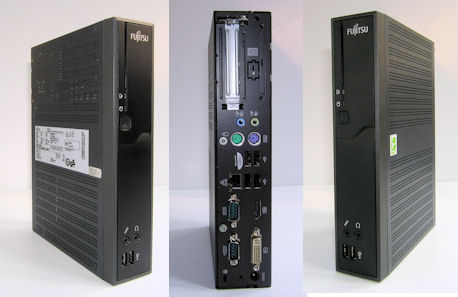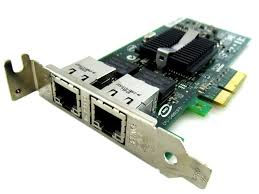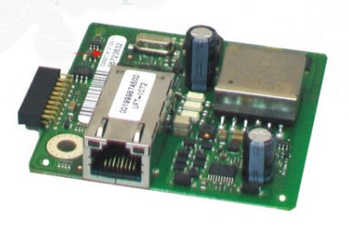
The Fujitsu Futro S900 is a neat unit that is based on a Fujitsu mini-ITX motherboard (D3003). The S900 was announced in May 2011. From the press release:
Fujitsu today announces the new FUTRO S700 and FUTRO S900 thin clients, the first Fujitsu thin clients to use innovative and eco-friendly Power over Ethernet (PoE) technology. Despite drawing only a trickle of power over Ethernet networks, the FUTRO S700 and FUTRO S900 are among the most powerful thin clients available today, boasting up to six times enhanced performance over previous models.
....The thin clients are even able to provide the processing capabilities to cope with rendering and performance-intensive 3D modelling: the Fujitsu models are among the first to introduce support for DirectX11 graphics technology.
The basic specs for the S900 are:
Processor Type
Model
SpeedAMD G-Series
G-T56N
1.65GHzG-T40N
1.00GHzG-T44R
1.20GHzMemory Flash
RAMmSATA 1GB-16GB
512MB/1GB (max 8GB)Video Chip
Max resolution
Radeon 6xxx
1920 x 1200 32-bit colour (DVI)
2560 x 1600 (display port)Ports Network
USB
Serial
Parallel
PS/210/100/1000
10 x USB2.0
2
0
Kybd & mousePower Power
Plug
Off
Idle
Running20V 2A (Label)
5.5mm/2.1mm coax
0W
10W
14WDimensions H x W x D (mm) 250 x 50 x 180
My S900 came without any flash memory fitted and so no operating system. The literature indicates that it either comes fitted with the eLux operating system or Windows Embedded Standard. The case of my S900 carries a sticker for Windows Embedded Standard (WS7E).
As far as CPU/RAM is concerned, my S900 was fitted with the 1.2GHz T44R CPU and 2GB of RAM.
The S900 uses a small external power supply that provides 20V at 2A. The connector is a standard 5.5mm/2.1mm coax connector. (Note: If you have various other thin clients lying around take care you don't use this in place of a standard 12V supply!). The data sheet for the D3003 gives 19V +/- 10% as the input voltage range accepted by the board with a typical current drain of 1A.
The S900 is fitted with an AMD G-Series CPU. From AMD's publicity material:
The AMD Embedded G-Series processor is the world's first integrated circuit to combine a low-power CPU and a discrete-level GPU into a single embedded Accelerated Processing Unit (APU). This unprecedented level of graphics integration builds a new foundation for high performance multi-media content delivery in a small form factor and power efficient platform for a broad range of embedded designs. Based on a power-optimized core, the AMD Embedded G-Series platform delivers levels of performance in a compact BGA package that is ideal for low power designs in embedded applications such as Digital Signage, x86 Set-Top Box (xSTB), IP-TV, Thin Client, Information Kiosk, Point-of-Sale, Casino Gaming, Media Servers, and Industrial Control Systems.
According to the data sheet the associated GPU is:
So the graphics in my S900 is a Radeon HD 6250.
- AMD Radeon HD 6320 (in combination with AMD G-Series G-T56N)
- AMD Radeon HD 6250 (in combination with AMD G-Series G-T44R)
- AMD Radeon HD 6290 (in combination with AMD G-Series G-T40N)
The Linux cpuinfo reports:
vendor_id : AuthenticAMD cpu family : 20 model : 2 model name : AMD G-T44R Processor stepping : 0 flags : fpu vme de pse tsc msr pae mce cx8 apic sep mtrr pge mca cmov pat pse36 clflush mmx fxsr sse sse2 syscall nx mmxext fxsr_opt pdpe1gb rdtscp lm constant_tsc rep_good nonstop_tsc extd_apicid aperfmperf pni monitor ssse3 cx16 popcnt lahf_lm svm extapic cr8_legacy abm sse4a misalignsse 3dnowprefetch ibs skinit wdt arat hw_pstate npt lbrv svm_lock nrip_save pausefilter vmmcall
00:00.0 Host bridge: Advanced Micro Devices, Inc. [AMD] Family 14h Processor Root Complex 00:01.0 VGA compatible controller: Advanced Micro Devices, Inc. [AMD/ATI] Wrestler [Radeon HD 6250] 00:01.1 Audio device: Advanced Micro Devices, Inc. [AMD/ATI] Wrestler HDMI Audio 00:04.0 PCI bridge: Advanced Micro Devices, Inc. [AMD] Family 14h Processor Root Port 00:11.0 SATA controller: Advanced Micro Devices, Inc. [AMD/ATI] SB7x0/SB8x0/SB9x0 SATA Controller [AHCI mode] (rev 40) 00:12.0 USB controller: Advanced Micro Devices, Inc. [AMD/ATI] SB7x0/SB8x0/SB9x0 USB OHCI0 Controller 00:12.2 USB controller: Advanced Micro Devices, Inc. [AMD/ATI] SB7x0/SB8x0/SB9x0 USB EHCI Controller 00:13.0 USB controller: Advanced Micro Devices, Inc. [AMD/ATI] SB7x0/SB8x0/SB9x0 USB OHCI0 Controller 00:13.2 USB controller: Advanced Micro Devices, Inc. [AMD/ATI] SB7x0/SB8x0/SB9x0 USB EHCI Controller 00:14.0 SMBus: Advanced Micro Devices, Inc. [AMD/ATI] SBx00 SMBus Controller (rev 42) 00:14.2 Audio device: Advanced Micro Devices, Inc. [AMD/ATI] SBx00 Azalia (Intel HDA) (rev 40) 00:14.3 ISA bridge: Advanced Micro Devices, Inc. [AMD/ATI] SB7x0/SB8x0/SB9x0 LPC host controller (rev 40) 00:14.4 PCI bridge: Advanced Micro Devices, Inc. [AMD/ATI] SBx00 PCI to PCI Bridge (rev 40) 00:14.5 USB controller: Advanced Micro Devices, Inc. [AMD/ATI] SB7x0/SB8x0/SB9x0 USB OHCI2 Controller 00:16.0 USB controller: Advanced Micro Devices, Inc. [AMD/ATI] SB7x0/SB8x0/SB9x0 USB OHCI0 Controller 00:16.2 USB controller: Advanced Micro Devices, Inc. [AMD/ATI] SB7x0/SB8x0/SB9x0 USB EHCI Controller 00:18.0 Host bridge: Advanced Micro Devices, Inc. [AMD] Family 12h/14h Processor Function 0 (rev 43) 00:18.1 Host bridge: Advanced Micro Devices, Inc. [AMD] Family 12h/14h Processor Function 1 00:18.2 Host bridge: Advanced Micro Devices, Inc. [AMD] Family 12h/14h Processor Function 2 00:18.3 Host bridge: Advanced Micro Devices, Inc. [AMD] Family 12h/14h Processor Function 3 00:18.4 Host bridge: Advanced Micro Devices, Inc. [AMD] Family 12h/14h Processor Function 4 00:18.5 Host bridge: Advanced Micro Devices, Inc. [AMD] Family 12h/14h Processor Function 6 00:18.6 Host bridge: Advanced Micro Devices, Inc. [AMD] Family 12h/14h Processor Function 5 00:18.7 Host bridge: Advanced Micro Devices, Inc. [AMD] Family 12h/14h Processor Function 7 01:00.0 Ethernet controller: Realtek Semiconductor Co., Ltd. RTL8111/8168/8411 PCI Express Gigabit Ethernet Controller (rev 06)
The details I can find on Fujitsu's site are all about the D3003-S. The S900 is fitted with the D3003-A12 board. (It's marked on a paper label that's only visible if you remove the memory SODIMM). The -Sxx variant has more features such as a second SATA port and other on-board connectivity.
As with various Fujitsu ITX motherboards you need to search for the 'TechNotes' to find some detailed information. (TechNotes_V3.1_Mini-ITX_D3003-S.pdf)
As this is based on a mini-ITX board there is obviously plenty of expansion opportunity starting with a reasonable amount of free space within the case where disk drives could be fitted. (Click on the photograph to get a more detailed view of the circuit board.)
CPU: Whilst the model range apparently encompasses a number of different CPUs, these are specific builds. The CPU comes in a BGA package and so is soldered to the board and not socketed.
Flash: The board carries an mSATA socket and a conventional SATA data socket. There is a connector by the SODIMM sockets labelled drive power.
RAM: The board has two SODIMM sockets for DDR3 1066MHz memory. (The data sheet does actually say: PC3-8500 or PC3-10600). Mine is fitted with a 2GB Micron part -MT8KTF25664HZ-1G4M1.
I originally wrote: "According to the data sheet the maximum that can be fitted is 4GB (2 x 2GB)."
In December 2019 I heard from Till who had successfully fitted 2 x 4GB Samsung SO-DIMMs (M47185273CH0) to get 8GB of RAM. I tried two Elpida parts in mine with equal success.
In February 2021 I heard from Justin who had a G-T56N running on a D3003-C1 motherboard. He had checked out the effect of using different speeds of RAM:
"PC3-10600 RAM runs at 1333 MHz. PC3-12800 RAM works, but not only will it **not** be running at 1600 MHz or even 1333MHz, it actually runs at the slower speed of 1066 MHz.The performance improvement of memory running at 1333 vs 1066 is small but observable. With the higher clock it can play 480p Youtube videos without skipping, 720p would have skipped frames; with the lower clock only 360p is playable, 480p has skipped frames, 720p is a slide show."
USB: There are two USB sockets on the front and four on the rear. Internally there are two headers on the motherboard that provide four further USB ports (I've checked). The paper spec says 8 ports, but my maths makes it 10.
PCI: There is a PCI socket. You will need a right-angle adaptor if you wish to press this into use.
PCIe: There is what looks to be a PCI-e X1 socket. On a board layout diagram I have it is identified as a 'PCI-e X1 socket'. However elsewhere in the same document it is identified as being a 'proprietary X2' socket.
In December 2017 Istvan discovered (as I subsequently did as well) that if you plug in one those PCI-e X1 extension cables into the socket on the motherboard, even with nothing plugged in the other end, the S900 will not power up. It was after finding this out that I looked further and discovered the 'proprietary X2' words hidden away in the D3003 documentation.
There is some very detailed technical documentation on the D3003-S motherboard on the Fujitsu website - use Google to search for the file TechNotes_V3.1_Mini-ITX_D3003-S.pdf. This includes the pinout for their PCIe connector which is significantly different from the standard. If you have any interest I've listed the connections here. The immediate killer is that pins A1, A2 and A3 are +12V in the standard but, whilst pins A1 and A2 are +12V on the D3003 connector, pin A3 is Ground. (My thanks to Goetz for drawing my attention to the PCIe details in the document).
 The photo on the right shows the official PCI-e Riser for the S900. The signal tracking on the
riser obviously remaps the signals from the onboard connector to the correct pins on the
PCIe x4 connector.
The photo on the right shows the official PCI-e Riser for the S900. The signal tracking on the
riser obviously remaps the signals from the onboard connector to the correct pins on the
PCIe x4 connector.
 In July 2018 I heard from Thierry who was using
one of these risers along with an Intel Pro 1000 card as part of a S900-based PFsense router.
In July 2018 I heard from Thierry who was using
one of these risers along with an Intel Pro 1000 card as part of a S900-based PFsense router.
In December 2019 I heard from Till who, as well as discovering that you could fit 8GB of RAM, had some comments of using POE to power the unit.
However so far I have had no success in powering it with POE. You can see that there must be a POE option as there is a spot below the PCI low profile bracket that can be broken out to fit a POE RJ45 socket. Right by the knock-out there is label with network and DC icons.
Internally you can see some pins next to the PCI connector that could connect to a special ethernet/POE interface board. It's obviously not the regular built in network interface that supports POE.
 Looking in the datasheet I find under:
Looking in the datasheet I find under:
Interface add on cards/components (optional)
a 2nd LAN/PoE module.
A quick Google found me the photo (right) and a €71 price tag. (About 9x what I paid for my S900 including postage, 60x if you exclude the postage!).